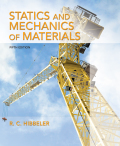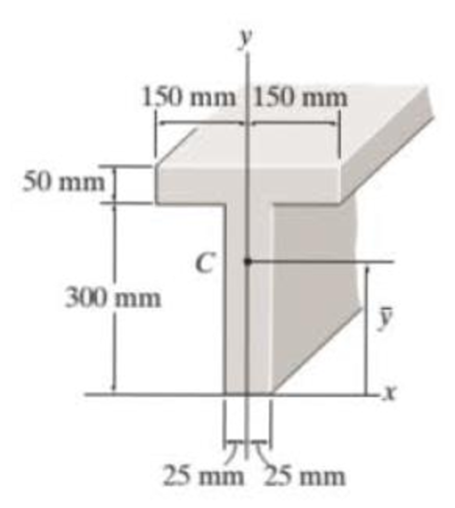
EBK STATICS AND MECHANICS OF MATERIALS
5th Edition
ISBN: 8220102955295
Author: HIBBELER
Publisher: PEARSON
expand_more
expand_more
format_list_bulleted
Concept explainers
Textbook Question
Chapter 6.2, Problem 8FP
Locate the centroid

Prob. F6–8
Expert Solution & Answer
Want to see the full answer?
Check out a sample textbook solution
Students have asked these similar questions
6.
Draw the isometric drawing for this problem(15%)
Please draw the section view of the following problems
7) Please draw the front, top and side view for the following object. Please cross this line out
Chapter 6 Solutions
EBK STATICS AND MECHANICS OF MATERIALS
Ch. 6.1 - In each case, use the element shown and specify...Ch. 6.1 - Prob. 1FPCh. 6.1 - Determine the centroid (x,y) of the area. Prob....Ch. 6.1 - Determine the centroid y of the area. Prob. F63Ch. 6.1 - Locate the center of gravity x of the straight rod...Ch. 6.1 - Prob. 5FPCh. 6.1 - Locate the centroid z of the homogeneous solid...Ch. 6.1 - Locate the centroid x of the area. Prob. 61Ch. 6.1 - Locate the centroid of the area. Prob. 62Ch. 6.1 - Locate the centroid x of the area. Probs. 63/4
Ch. 6.1 - Locate the centroid y of the area. Probs. 63/4Ch. 6.1 - Locate the centroid x of the area. Probs. 65/6Ch. 6.1 - Locate the centroid y of the area. Probs. 65/6Ch. 6.1 - Prob. 7PCh. 6.1 - Prob. 8PCh. 6.1 - Locate the centroid x of the area. Solve the...Ch. 6.1 - Prob. 10PCh. 6.1 - Prob. 11PCh. 6.1 - Prob. 12PCh. 6.1 - Locate the centroid y of the area. Probs. 612/13Ch. 6.1 - Prob. 14PCh. 6.1 - Prob. 15PCh. 6.1 - Prob. 16PCh. 6.1 - Locate the centroid x of the area. Probs. 617/18Ch. 6.1 - Prob. 18PCh. 6.1 - Prob. 19PCh. 6.1 - Locate the centroid x of the area. Probs. 620/21Ch. 6.1 - Locate the centroid y of the area. Probs. 620/21Ch. 6.1 - Locate the centroid x of the area. Probs. 622/23Ch. 6.1 - Prob. 23PCh. 6.1 - Prob. 24PCh. 6.1 - Prob. 25PCh. 6.1 - Prob. 26PCh. 6.1 - Prob. 27PCh. 6.1 - The steel plate is 0.3 m thick and has a density...Ch. 6.1 - Prob. 29PCh. 6.1 - Prob. 30PCh. 6.1 - Prob. 31PCh. 6.1 - Prob. 32PCh. 6.1 - Prob. 33PCh. 6.1 - Locate the centroid z of the volume. Prob. 634Ch. 6.1 - Prob. 35PCh. 6.2 - Locate the centroid (x,y,z) of the wire bent in...Ch. 6.2 - Locate the centroid y of the beams cross-sectional...Ch. 6.2 - Locate the centroid y of the beams cross-sectional...Ch. 6.2 - Prob. 10FPCh. 6.2 - Prob. 11FPCh. 6.2 - Prob. 12FPCh. 6.2 - Locate the centroid (x,y) of the area. Prob. 636Ch. 6.2 - Locate the centroid y for the beams...Ch. 6.2 - Locate the centroid y of the beam having the...Ch. 6.2 - Locate the centroid (x,y) of the area. Prob. 639Ch. 6.2 - Locate the centroid y of the beams cross-sectional...Ch. 6.2 - Locate the centroid (x,y) of the area. Prob. 641Ch. 6.2 - Locate the centroid (x,y) of the area. Prob. 642Ch. 6.2 - Prob. 43PCh. 6.2 - Locate the centroid y of the cross-sectional area...Ch. 6.2 - Prob. 45PCh. 6.2 - Prob. 46PCh. 6.2 - Prob. 47PCh. 6.2 - Prob. 48PCh. 6.2 - Prob. 49PCh. 6.2 - Prob. 50PCh. 6.2 - Prob. 51PCh. 6.2 - Locate the center of gravity z of the assembly....Ch. 6.2 - Major floor loadings in a shop are caused by the...Ch. 6.2 - The assembly consists of a 20-in. wooden dowel rod...Ch. 6.2 - The composite plate is made from both steel (A)...Ch. 6.4 - Determine the moment of inertia of the area about...Ch. 6.4 - Prob. 14FPCh. 6.4 - Prob. 15FPCh. 6.4 - Determine the moment of inertia of the area about...Ch. 6.4 - Prob. 56PCh. 6.4 - Prob. 57PCh. 6.4 - Prob. 58PCh. 6.4 - Prob. 59PCh. 6.4 - Determine the moment of inertia for the area about...Ch. 6.4 - Determine the moment of inertia for the area about...Ch. 6.4 - Prob. 62PCh. 6.4 - Prob. 63PCh. 6.4 - Prob. 64PCh. 6.4 - Prob. 65PCh. 6.4 - Prob. 66PCh. 6.4 - Prob. 67PCh. 6.4 - Prob. 68PCh. 6.4 - Prob. 69PCh. 6.4 - Prob. 70PCh. 6.4 - Prob. 71PCh. 6.4 - Prob. 72PCh. 6.4 - Prob. 73PCh. 6.4 - Prob. 74PCh. 6.4 - Prob. 75PCh. 6.4 - Prob. 76PCh. 6.4 - Determine the moment of inertia for the area about...Ch. 6.4 - Determine the moment of inertia for the area about...Ch. 6.4 - Prob. 79PCh. 6.5 - Determine the moment of inertia of the...Ch. 6.5 - Determine the moment of inertia of the...Ch. 6.5 - Prob. 19FPCh. 6.5 - Determine the moment of inertia of the...Ch. 6.5 - Determine the moment of inertia of the composite...Ch. 6.5 - Determine the moment of inertia of the composite...Ch. 6.5 - Prob. 82PCh. 6.5 - Determine the location y of the centroid of the...Ch. 6.5 - Determine y, which locates the centroidal axis x...Ch. 6.5 - Prob. 85PCh. 6.5 - Prob. 86PCh. 6.5 - Determine the moment of inertia Ix of the area...Ch. 6.5 - Determine the moment of inertia Ix of the area...Ch. 6.5 - Determine the moment of inertia of the...Ch. 6.5 - Determine y, which locates the centroidal axis x...Ch. 6.5 - Determine the moment of inertia of the...Ch. 6.5 - Determine the moment of inertia of the...Ch. 6 - Locate the centroid x of the area.Ch. 6 - Locate the centroid y of the area.Ch. 6 - Locate the centroid of the rod.Ch. 6 - Prob. 4RPCh. 6 - Determine the moment of inertia for the area about...Ch. 6 - Prob. 6RPCh. 6 - Determine the area moment of inertia of the...
Knowledge Booster
Learn more about
Need a deep-dive on the concept behind this application? Look no further. Learn more about this topic, mechanical-engineering and related others by exploring similar questions and additional content below.Similar questions
- A 10-kg box is pulled along P,Na rough surface by a force P, as shown in thefigure. The pulling force linearly increaseswith time, while the particle is motionless att = 0s untilit reaches a maximum force of100 Nattimet = 4s. If the ground has staticand kinetic friction coefficients of u, = 0.6 andHU, = 0.4 respectively, determine the velocityof the A 1 0 - kg box is pulled along P , N a rough surface by a force P , as shown in the figure. The pulling force linearly increases with time, while the particle is motionless at t = 0 s untilit reaches a maximum force of 1 0 0 Nattimet = 4 s . If the ground has static and kinetic friction coefficients of u , = 0 . 6 and HU , = 0 . 4 respectively, determine the velocity of the particle att = 4 s .arrow_forwardCalculate the speed of the driven member with the following conditions: Diameter of the motor pulley: 4 in Diameter of the driven pulley: 12 in Speed of the motor pulley: 1800 rpmarrow_forward4. In the figure, shaft A made of AISI 1010 hot-rolled steel, is welded to a fixed support and is subjected to loading by equal and opposite Forces F via shaft B. Stress concentration factors K₁ (1.7) and Kts (1.6) are induced by the 3mm fillet. Notch sensitivities are q₁=0.9 and qts=1. The length of shaft A from the fixed support to the connection at shaft B is 1m. The load F cycles from 0.5 to 2kN and a static load P is 100N. For shaft A, find the factor of safety (for infinite life) using the modified Goodman fatigue failure criterion. 3 mm fillet Shaft A 20 mm 25 mm Shaft B 25 mmarrow_forward
- Please sovle this for me and please don't use aiarrow_forwardPlease sovle this for me and please don't use aiarrow_forward3. The cold-drawn AISI 1040 steel bar shown in the figure is subjected to a completely reversed axial load fluctuating between 28 kN in compression to 28 kN in tension. Estimate the fatigue factor of safety based on achieving infinite life (using Goodman line) and the yielding factor of safety. If infinite life is not predicted, estimate the number of cycles to failure. 25 mm + 6-mm D. 10 mmarrow_forward
- CORRECT AND DETAILED SOLUTION WITH FBD ONLY. I WILL UPVOTE 1. The truss shown is supported by hinge at A and cable at E.Given: H = 4m, S = 1.5 m, α = 75⁰, θ = 33⁰.Allowable tensile stress in cable = 64 MPa.Allowable compressive stress in all members = 120 MPaAllowable tensile stress in all members = 180 MPa1.Calculate the maximum permissible P, in kN, if the diameter of the cable is 20 mm.2.If P = 40 kN, calculate the required area (mm2) of member BC.3. If members have solid square section, with dimension 15 mm, calculate the maximum permissible P (kN) based on the allowable strength of member HI.ANSWERS: (1) 45.6 kN; (2) 83.71 mm2; (3) 171.76 kNarrow_forwardCORRECT AND DETAILED SOLUTION WITH FBD ONLY. I WILL UPVOTE 2: A wire 4 meters long is stretched horizontally between points 4 meters apart. The wire is 25 mm2 in cross-section with a modulus of elasticity of 200 GPa. A load W placed at the center of the wire produces a sag Δ.1.Calculate the tension (N) in the wire if sag Δ = 30 mm.2.Calculate the magnitude of W, in N, if sag Δ = 54.3 mm.3. If W is 60 N, what is the sag (in mm)?ANSWERS: (1) 562 N, (2) 100 N, (3) 45.8 Narrow_forwardCORRECT AND DETAILED SOLUTION WITH FBD ONLY. I WILL UPVOTE 4 : A cable and pulley system at D is used to bring a 230-kg pole (ACB) to a vertical position as shown. The cable has tensile force T and is attached at C. The length of the pole is 6.0 m, the outer diameter is d = 140 mm, and the wall thickness t = 12 mm. The pole pivots about a pin at A. The allowable shear stress in the pin is 60 MPa and the allowable bearing stress is 90 MPa. The diameter of the cable is 8 mm.1.Find the minimum diameter (mm) of the pin at A to support the weight of the pole in the position shown.2.Calculate the elongation (mm) of the cable CD.3.Calculate the vertical displacement of point C, in mm.ANSWERS: (1) 6 mm, (2) 1.186 mm, (3) 1.337 mm--arrow_forward
arrow_back_ios
SEE MORE QUESTIONS
arrow_forward_ios
Recommended textbooks for you
 International Edition---engineering Mechanics: St...Mechanical EngineeringISBN:9781305501607Author:Andrew Pytel And Jaan KiusalaasPublisher:CENGAGE L
International Edition---engineering Mechanics: St...Mechanical EngineeringISBN:9781305501607Author:Andrew Pytel And Jaan KiusalaasPublisher:CENGAGE L

International Edition---engineering Mechanics: St...
Mechanical Engineering
ISBN:9781305501607
Author:Andrew Pytel And Jaan Kiusalaas
Publisher:CENGAGE L
Mechanical Engineering: Centroids & Center of Gravity (1 of 35) What is Center of Gravity?; Author: Michel van Biezen;https://www.youtube.com/watch?v=Tkyk-G1rDQg;License: Standard Youtube License